Are you a Quiet Speculation member?
If not, now is a perfect time to join up! Our powerful tools, breaking-news analysis, and exclusive Discord channel will make sure you stay up to date and ahead of the curve.
A lot happened since Monday morning. At 9:39 AM, Wizards released its April 4 banlist update. About five seconds after 9:39 AM, the Modern community went nuts. While some have criticized aspects of the update, the overwhelming majority of players responded on the scale of cautious optimism to frenzied ecstasy. Surprising no one who lived through the post-Modern Masters 2015 spikes, Magic markets reacted immediately. Eldrazi staples crumpled into the single-digits. Meanwhile, the unbanned cards and their engines skyrocketed like the price of a Comcast XFINITY bundle after its promotion ends. This elation will surely pass as Modern evolves around the new environment, but the April 4 update will still remain a significant moment in format history. Today, we are going to investigate why it is so important, focusing on the format policy perspective.
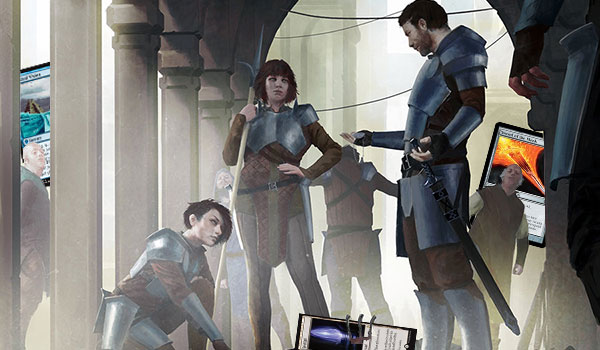
By the end of this week, I expect we'll see about 10-12 banlist pieces from major content sites. We're already on track as of Tuesday evening, with my Monday piece being joined by Reid Duke's on Channel Fireball, followed again by Mike Sigrist's on StarCityGames Premium from today. Add a Mana Source video and a TCGPlayer "Fact or Fiction" breakdown and we're actually fixing to exceed our weekly target. Get used to it. This update is arguably more significant than the recent Splinter Twin ban in January, and we all know how formative that was. As I promised on Monday, today's article is a deep-dive into the most important consequences of Eye of Ugin's banning and Ancestral Vision's and Sword of the Meek's release, paying special attention to banlist and format management takeaways. Although metagame implications are important too, there has been plenty of discussion on these effects and not nearly enough on the update's impact on Modern as a format.
[wp_ad_camp_1]
Analyzing Source Material
Wizards doesn't have great communication surrounding Modern. It's getting better, but it remains a historic problem. I've examined this in two separate "Fixing Modern" columns, one on "Defining Format Mission" and another on "Improving Communication," and I'm certain we'll revisit this challenge again in the future. After all, the Pro Tour and Splinter Twin fiasco are still hanging over us. That said, banlist  updates are one of the rare sources of Modern information which are simultaneously accessible, accurate, and helpful. Personally, I love reading banlist announcements. And re-reading them. And re-re-reading them... When there aren't many accessible/accurate/helpful sources of information about Modern management, you need to analyze the material you do have, not complain about what you lack.
updates are one of the rare sources of Modern information which are simultaneously accessible, accurate, and helpful. Personally, I love reading banlist announcements. And re-reading them. And re-re-reading them... When there aren't many accessible/accurate/helpful sources of information about Modern management, you need to analyze the material you do have, not complain about what you lack.
In that spirit, the April 4 update is easily one of the best troves of Modern information out there. At almost 900 words in the Modern section alone, it's the longest announcement to-date, and Wizards doesn't waste a single letter conveying their decision-making process. I respect this clarity and comprehensiveness and you should too. What's the best way to pay those respects, besides Tweets of praise to Aaron Forsythe and his team? Re-re-re-reading the update!
Click here --> April 4, 2016 Banned and Restricted Announcement <-- Click here
Back in college, I remember doing far too many "close-readings" of various texts. One of my friends accomplished this in a windowless study cubicle with 12 cans of Mountain Dew. Another never picked up the books until the hour before class and read them an inch from his face. Whether you're a believer or a mocker of the close-read, it's a useful tool for understanding the kind of high-level takeaways in the recent update. Let's take one last re^4-read before we break out our Shadows Over Innistrad investigator hats and Magnifying Glasses to analyze the decision.
The Anatomy of a Ban
Eye of Ugin's banning was the update's most predictable element. Aaron Forsythe had already declared Modern a DEFCON 1 in the wake of Grand Prix Detroit, and practically a Modern article hadn't gone by without either suggesting the impending ban or assuming it. Because Eye's eventual demise was so obvious, it's easy to speed through the Eldrazi part of the announcement. I can't blame you: who wants to read another word about the tentacled tyrants? That said, more than 60% of the announcement's Modern content focuses on Eye's execution alone. The text is packed with important takeaways about both this ban and future bans alike. We'll need to brave the Eldrazi Winter one last time as we explore the ban-related takeaways before moving to details about unbans.
Data-driven bannings
Contrary to opinions of your average Modern detractor, Wizards often uses data to inform bans. Almost every past Modern banlist update made some reference to tournament results and April 4's was no exception. I've done a relatively thorough overview of previous announcements in my "Last Word on the Splinter Twin Ban" article from January, and I encourage you to read the first section for a summary of those different ban explanations. Sam Stoddard also confirmed this data-driven approach in his fantastic "Using Real-World Data" article, one of those re-re-read pieces you'll want bookmarked in your Modern favorites. Eye's ban rationale gives us even more information about how Wizards uses tournament results to inform banlist decisions, and we can use the April 4 text to further sharpen our understanding of this often opaque process.
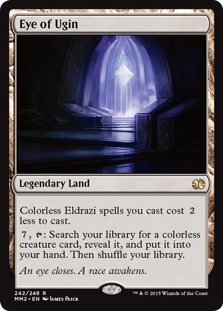 Eye's obituary makes two references to real-world event data. The first discusses Pro Tour and Grand Prix tournaments:
Eye's obituary makes two references to real-world event data. The first discusses Pro Tour and Grand Prix tournaments:
"At the Pro Tour, Eldrazi were represented in six of the Top 8 decks, including Jiachen Tao's winning deck. On the weekend of March 6, three Modern Grand Prix were held, in Melbourne, Bologna, and Detroit. There were 24 players who had Top 8 performances, fourteen of whom were playing Eldrazi, including two of the three winning decks."
Wizards of the Coast, "April 4, 2016 Banned and Restricted Announcement" (April 4, 2016)
The second mentions Magic: The Gathering Online results, concluding with a statement that could refer to MTGO stats in particular or, more likely, to the state of Modern as a whole:
"Results on Magic Online are quite similar. Eldrazi decks are running rampant. The format is very imbalanced, and far from a healthy mix of competitive decks."
Wizards of the Coast, "April 4, 2016 Banned and Restricted Announcement" (April 4, 2016)
Before we start parsing these quotes or describing a banning formula, it's important to acknowledge the pitfalls in this kind of extrapolation. Wizards' banning process is probably more flexible and nuanced than any single "rule" could describe. That or it's totally scattershot, like many of my own middle-management meetings. Either way, we're in uncertain waters when trying to attribute a model to this kind of process. Thankfully, this is Modern Nexus and I'm comfortable trying to identify a pattern to the best of our abilities with all available evidence. Banlist speculation is guaranteed to continue in Modern, and I'd rather it be grounded in careful analysis than Internet hyperbole and rage faces.
With that in mind, these two quotes from the April 4 update give important definition to a process we've seen develop in the past and seen explained in Stoddard's "Real-World Date" article.
As with the Twin ban decision and every preceding update, the April 4 announcement explicitly mentions Top 8 performances. Not Day 1 shares. Not Day 2 prevalence. Not even Top 16 or Top 32 standings. It's all Top 8, all the time. Although I believe other metagame indicators are also used to determine bannings (more on that shortly), the evidence now firmly points to Top 8s being the primary determinant of bans. For instance, compare the discussion of Eye's tournament performances with that of Twin's in the January update:
"Antonio Del Moral León won Pro Tour Fate Reforged playing Splinter Twin, and Jelger Wiegersma finished third; Splinter Twin has won two of the four Modern Pro Tours. Splinter Twin reached the Top 8 of the last six Modern Grand Prix. The last Modern Grand Prix in Pittsburgh had three Splinter Twin decks in the Top 8, including Alex Bianchi's winning deck."
Wizards of the Coast, "January 18, 2016 Banned and Restricted Announcement" (January 18, 2016)
Given that every update mentions Top 8s, whereas only some mention MTGO or paper prevalence, it's hard to identify any other factor as a primary driver. Indeed, it's also hard to deny there is a primary driver at all: the Top 8 reference is just too consistent to indicate much else. This puts a quote from Stoddard's "Real-World Data" piece in new light. After explaining how time-consuming the data-collection and analysis processes are, Stoddard mentions what Wizards is capable of doing:
"We can look at what decks are winning, as well as the Top 8 decks at independent tournament series, and use that as a baseline for what the Magic populace enjoys and what is succeeding."
Sam Stoddard, "Using Real-World Data" (February 11, 2016)
Key word: "winning." Key term: "Top 8 decks at independent tournament series." Stoddard's words point most directly to actual Top 8 wins, not just Day 1 wins to reach Day 2, or League wins to reach the top of an MTGO queue. This focus is amply supported by the different ban updates that all made consistent and 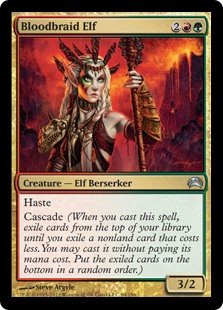 regular mention of Top 8s since Bloodbraid Elf bit the dust. Taken as a whole, this means we need to consider Top 8s as the primary decider of a ban. Unhealthy Top 8 shares, as defined by the precedent of unhealthy decks like Eldrazi, Delver, Pod, etc., is a sure sign of a pending ban.
regular mention of Top 8s since Bloodbraid Elf bit the dust. Taken as a whole, this means we need to consider Top 8s as the primary decider of a ban. Unhealthy Top 8 shares, as defined by the precedent of unhealthy decks like Eldrazi, Delver, Pod, etc., is a sure sign of a pending ban.
But what about MTGO and Day 2 shares? Readers will remember I've cited these before, notably in my Twin banning indictment, and I can already hear Twin ban defenders and commentators heading down to the comments to have their "I told you so" moment. Let's ignore the Twin ban in itself. For some, it's hard to talk about without losing their minds. For others, it's hard to read another word of the ban without wanting to stop reading. Instead, let's look at where other ban announcements did mention factors like MTGO or non-Top 8 shares.
Although the Twin ban did not make this reference, Bloodbraid Elf's, Birthing Pod's, and now Eye of Ugin's definitely did. Bloodbraid's mentioned Jund performances in the Top 16 at Grand Prix Bilbao. Pod's talked about the deck both winning Grand Prix but also occupying a high share of the field on top of its wins. Then there's Eye's explanation, which explicitly calls out MTGO. That said, there are some announcements which make no reference to Top 16s, Day 2s, MTGO, or anything else, or only a cryptic and ambiguous mention. Stoddard also clarifies the importance of MTGO in his article:
"Fortunately for us, we do get a ton of very useful data from Magic Online. Between Leagues, on-demand queues, and premier events, we know a lot about the decks that are winning. Beyond just seeing what won, we also get very accurate matchup percentages as well as percentages of decks in the metagame."
Sam Stoddard, "Using Real-World Data" (February 11, 2016)
Going ahead, this means we need to consider Top 8s before all else in ban decisions, with MTGO, Top 16s, Day 2s, etc. as only supporting factors. Within those secondary factors, MTGO is the most decisive, with the others falling behind. It was easy to suspect such a weighting before Eye's ban and Stoddard's article, but the evidence against this position was at least as strong as the evidence supporting it. Now, the combination of the Twin ban, the Stoddard article, and the Eye ban much more strongly suggest a hierarchy of data when it comes to determining bans. Top 8s come first. MTGO comes second. Everything else is tertiary to that.
Surgical ban strikes
We're a data-driven website, so I've spent much more time on the data-driven elements of banning than I will on the other dimensions of Eye of Ugin's destruction. That said, there's much more to Eye's ban than just the data side, even if that side is probably the most  important. One of the other critical takeaways from Eye's ban is Wizards preference to conduct tactical, limited-end strikes on problematic decks. They don't want to carpet bomb an entire strategy into dust, Ted Cruz style. The banlist update couldn't be much more direct about this:
important. One of the other critical takeaways from Eye's ban is Wizards preference to conduct tactical, limited-end strikes on problematic decks. They don't want to carpet bomb an entire strategy into dust, Ted Cruz style. The banlist update couldn't be much more direct about this:
"While the Eldrazi decks have a lot of powerful cards, the powerful draws are generally based on the mana acceleration from Eldrazi Temple and Eye of Ugin. Rather than ban multiple creatures, we find it preferable to ban a single land."
Wizards of the Coast, "April 4, 2016 Banned and Restricted Announcement" (April 4, 2016)
It's hard to know why Wizards prefers single-card bans to multiple ones. Perhaps the length of a banlist matters. Tom LaPille's old "Welcome to the Modern World" article suggests as much, stating "First, this list is a lot longer than it was at the Community Cup. By default, Magic players tend to want to play with more cards rather than less, and react unhappily when a card they like is banned." Maybe Wizards doesn't want the bad press of a silly looking banlist with Endless One. It's possible Wizards just wants to sell Oath packs and is obscuring the issue by banning an old card rather than a newer toy.
Whatever the reason, the April 4 update confirms Wizards' continued preference for banning as little as possible in offending decks. We saw this in the Summer Bloom ban as well, and I expect we'll see it again, both when decks are too dominant and when they violate the turn four rule.
Maximizing interactivity and diversity
Leading up to the April 4 deadline, there was considerable debate over banning Eye or banning Eldrazi Temple. Everyone knew at least one of them had to go (everyone except some die-hard Eldrazi sympathizers who wanted to keep Smashing and Seering their way through tournaments), and there were decent arguments on both sides of the conversation. In explaining their choice of Eye, Wizards not only stayed in dialogue with this community-wide discussion, but also hinted at some important considerations in how they value interaction and diversity.
During the April 4 article, Wizards considers the likely results of an Eldrazi Temple ban:
"If Eldrazi Temple is banned and Eye of Ugin is legal, the deck focuses on playing multiple lower-casting-cost Eldrazi per turn. A discount of two mana for each Eldrazi becomes a discount of four or more over the course of a turn. The deck becomes more explosive, more focused on a single build, and the powerful draws are still not interactive."
Wizards of the Coast, "April 4, 2016 Banned and Restricted Announcement" (April 4, 2016)
Here, we see two Modern elements Wizards tries to combat. The first is homogeneity. Wizards does not want decks to be "focused on a single build" if there is potential for diversity within that build. Eye of Ugin decks are heavily Eldrazi-oriented, gravitating towards 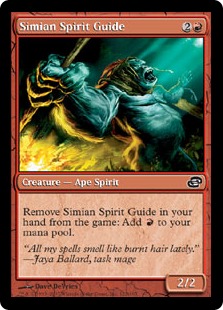 Urborg, Tomb of Yawgmoth and Simian Spirit Guide to maximize explosive starts. Eldrazi Temple decks range from UW grinders to RG aggro, with even non-Eldrazifed strategies, like those Jordan described in February.
Urborg, Tomb of Yawgmoth and Simian Spirit Guide to maximize explosive starts. Eldrazi Temple decks range from UW grinders to RG aggro, with even non-Eldrazifed strategies, like those Jordan described in February.
Wizards also tries to reduce non-interactivity. Decks need to give their opponents a window for interaction, whether that's removal, discard, countermagic, blockers, or some other form of disruption. We've known about Wizards' diversity paradigm for a while now (it's mentioned in essentially every bit of Modern press), but it's nice to get more information about interaction. Notably, the notion of certain Eldrazi draws not being interactive returns to an earlier Stoddard piece about Modern development. Speaking about All-In-Red and mana acceleration, Stoddard breaks down the struggle:
"In some sense, this deck isn't inherently unbalanced—after all, plenty of decks can deal with one of these turn-one threats after All-In-Red has, as named, gone all in; and thereby have an easy time winning the game. But it's not the sort of game play that we want to encourage in Modern. Turn one: make a huge play. If you can beat it, you win; if not, I win."
Sam Stoddard, "Development Risks in Modern" (May 22, 2015)
It's important not to put too much emphasis on the notion of a turn one "huge play" as it relates to bans. Such lines are inevitable in Modern, and range from aggressive Affinity starts to hand-crunching Jund openers. That said, when the huge play is happening in a deck that is already stifling format diversity, it becomes much more problematic. These factors combined to guarantee an Eye of Ugin ban.
As a whole, this is an important lesson for future banlist speculation. When Wizards bans cards from problematic decks, they will ban to encourage the most diverse builds, while also maximizing deck interactivity. We saw this at play in the Twin ban. A Splinter Twin ban leaves various flavors of URx decks intact, even if those decks needed some extra help in the form of Ancestral Vision. A Snapcaster Mage or Deceiver Exarch ban might de-power the deck, but it doesn't do a thing for net format diversity within Twin or URx decks. As for interactivity, Wizards is going to aim at cards that reduce interaction in a matchup, especially surrounding explosive starts. For instance, if (a big if) Affinity ever needed a ban, that would put something like Mox Opal right in the crosshairs.
Minimizing and accepting collateral damage
The final banning takeaway to focus on today involves innocent Modern bystanders. One of the most common objections to a given ban is the notion that it might hurt a guiltless deck. For example, poor Shamans players losing Deathrite when the one-mana planeswalker took the fall for BGx Midrange's sins. Or, to cite more recent arguments, Ad Nauseam pilots defending Simian Spirit Guide when most the hate for the Ape stems from Goryo's Vengeance combo decks and turn one Chalice of the Void. With Eye of Ugin's much-deserved departure from Modern, we must also reconsider these defenses.
One of the most prolific arguments against an Eye of Ugin ban concerned incidental damage to RG Tron. Wizards responds to this in the update:
"While the Eye does add a lot of late game power to the deck, the core gameplay of the deck—casting large threats with the Tron lands—remains intact. It is regrettable that banning Eye of Ugin also impacts these Tron decks, but weighing everything in consideration, we feel this is the correct solution to the Eldrazi menace and makes Modern the most fun overall."
Wizards of the Coast, "April 4, 2016 Banned and Restricted Announcement" (April 4, 2016)
This quote introduces an important dimensions that Wizards may weigh when inadvertently harming one deck with a ban targeted at another: the concept of a deck remaining "intact." The excerpt suggests Wizards accepts some degree of collateral damage if the damaged decks preserves its "core gameplay." In Tron's case, although Eye provided inevitability and a late-game solution to flooding, its banning doesn't really affect the primary plan of assembling Urzatron into turn three Karn Liberated or turn four Ugin, the Spirit Dragon. Note that WIzards never talks about the viability or competitiveness of the deck. They merely discuss its "core gameplay," which I read as more of a central deck identity and not its tiering.
Note that WIzards never talks about the viability or competitiveness of the deck. They merely discuss its "core gameplay," which I read as more of a central deck identity and not its tiering.
We can readily apply this to other future scenarios. For example, an Affinity-centered Mox Opal ban would certainly injure Lantern Control, but because Lantern's core prison strategy would stay together, we couldn't rule out Opal entirely. A Grishoalbrand-related Simian Spirit Guide ban could also fall in this category, despite Ad Nauseam being in the line of fire. After all, the main synergies of Ad Nauseam, Angel's Grace, Lightning Storm, and Phyrexian Unlife would still be present. As Wizards might assert, Ad Nauseam pilots would just need to wait a turn to execute their combo, using something like Infernal Plunge and a lone Memnite instead of the free Guides. I'm not personally making this evaluation, but the Eye and Tron case suggests it could happen in an update to come. It already happened to the poor Kiki Pod pilots, whose decks were not involved in the Siege Rhino-powered Pod dominance of 2014, so don't be surprised to see it again.
Informing future bans
One banlist update, one card banned, and at least four major takeaways for future banlist policy. Talk about improving communication! Although Wizards has not confirmed any of our observations to be ban process rules, we've seen them all in action in the April 4 update, Modern policy articles, and previous banlist announcements. To review, here are the four high-level implications of Eye of Ugin's ban.
- When using real-world data to inform bans, Wizards prioritizes major event Top 8s first, MTGO prevalence second, and other measures of metagame diversity third.
- Wizards prefers to ban the fewest cards that have the highest impact in a problematic deck.
- Bans should maximize diversity across the format, diversity within certain strategies, and Modern-wide interaction.
- Collateral damage is acceptable in bans, so long as the "core gameplay" of affected decks remains largely intact.
As 2016 unfolds and we undoubtedly see more Modern bans, I'll be checking to see if these takeaways are predictive of future banning decisions, or just descriptive of ones we've seen in the past. Time will tell, and hopefully we don't encounter another Eldrazi to do the telling. If nothing else, this limited model of Wizards' banlist policy gives us a nuanced and critical foundation for future ban discussion, one I'll certainly return to as we approach later banlist announcments.
The Unbanning Process
Of course, Eye of Ugin's banning was only one part of the three-part Modern update. For many, it probably wasn't even the most exciting change. The dual Ancestral Vision and Sword of the Meek unban was unprecedented and thrilling on many levels, and I want to wrap up today's article with a rapid-fire rundown of all the consequences for subsequent unbans. If you think we've spent too much time on bans, welcome to my Modern world! Ban suggestions are far more common than unban ones, both because they are reactions to real events and experiences, and because Modern has had far more bans than unbans. Even the update itself spent more words on the one ban than the two unbans. We're shifting gears now to the boundless possibilities of Modern unbannings, and the series of critical takeaways we'll need to remember as we vouch for more pardons down the road.
- Unbans no longer just happen before the Pro Tour
Up until April 4, every single Modern unban happened on the eve of a Pro Tour. This led many players to allege Wizards would only unban cards before a Pro Tour, whether to spice up a stale format, generate format excitement around an event, make sure the banlist changes got lots of press, or any number of other reasons. All of that is out the window as of April 4. With no Pro Tour on the horizon and two major unbans in circulation, we can no longer accuse Wizards of chaining unbans to the Modern Pro Tour. Of course, this doesn't mean Wizards lacks secondary motives, whether "apologizing" for the warped Eldrazi Winter with a double unban, pushing a post-Twin URx agenda, presaging the end of a Modern Pro Tour next year, or something else. It's all speculation for now, but the end of pre-Pro Tour unbans is as real as the four Ancestral Visions finally free of my tradebinder.
- Unbans help underplayed decks, not top-tier decks
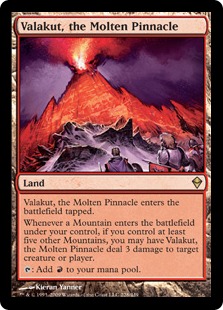 Between Valakut, the Molten Pinnacle, Bitterblossom, Wild Nacatl, Golgari Grave-Troll, and now Vision and Sword, Wizards has never unbanned a card that readily slotted into a top-tier deck. Wizards cites this not once but twice in the April 4 update, first with Vision ("To allow for an increase in the number of blue-based control or attrition decks, we are unbanning Ancestral Vision") and then again with Sword ("To allow for an increase in the number of controlling combo decks in the format, we are unbanning Sword of the Meek"). Barring a major format or ban policy shift, we should not expect that to change in future updates. That is good news for something like Jace, the Mind Sculptor if blue-based decks remain bad, but bodes poorly for the artifact lands.
Between Valakut, the Molten Pinnacle, Bitterblossom, Wild Nacatl, Golgari Grave-Troll, and now Vision and Sword, Wizards has never unbanned a card that readily slotted into a top-tier deck. Wizards cites this not once but twice in the April 4 update, first with Vision ("To allow for an increase in the number of blue-based control or attrition decks, we are unbanning Ancestral Vision") and then again with Sword ("To allow for an increase in the number of controlling combo decks in the format, we are unbanning Sword of the Meek"). Barring a major format or ban policy shift, we should not expect that to change in future updates. That is good news for something like Jace, the Mind Sculptor if blue-based decks remain bad, but bodes poorly for the artifact lands.
- Unbans help under-represented archetypes, not common ones
As a corollary to the above point, Wizards also has a pulse on what archetypes are played in Modern, not just individual strategies. As they said in the April 4 update, "Currently, the format tends to favor aggressive decks and quick-kill combo decks. We looked for cards that tend to work best in slower decks." Keep this in mind as you predict unbans in future metagames. If aggro and combo are running rampant, that's not the time to support a #FreeDread Return campaign. If aggro decks are barely surviving a tide of Thopters, Stoneforge Mystic is probably staying where she is.
- Wizards does not appear to thoroughly test unbans
Forsythe and others have gone on record numerous times stating they don't explicitly test for Modern, but it was always less clear how often they test for the banlist update. The April 4 announcement suggests the answer is "not much" or "not at all." In introducing the two unbans, Wizards explains "While there is some risk that these cards will cause further problems, we think that risk is small. Sometimes unbanning these cards doesn't create any change in the competitive metagame." I might be reading too much into this, but that's not the confidence of someone who has tested hundreds of games with dozens of decks. To me, that suggests a simple cost-benefit, risk-reward analysis done by R&D members in a boardroom. I'm sure these conversations are deep and rich with historic and contemporary examples, but I doubt they involve much hard testing. As a content producer, this makes articles like my Stoneforge vs. Affinity series feel more valuable: Wizards might not be doing the testing at all so we need to pick up the slack.
- Bloodbraid Elf is getting sold down the river
We'll wrap up our takeaways list by zeroing in on Jund's leading lady, an iconic Elf who is getting kicked down the creek by Wizards. Although Bloodbraid absolutely does not meet a number of our unbanning criteria above (Jund isn't remotely "underplayed"), she's also getting badly misrepresented in the April 4 article: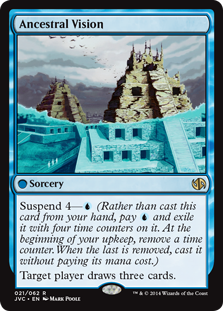 "With the current banned list, including Bloodbraid Elf, the types of cascade cards usually played with Ancestral Vision are not available." This should be an alarming quote for Bloodbraid hopefuls, because it suggests there is an added impediment to her freedom: cascade combos with Vision. I'm sure this arises from the Shardless Agent example in Legacy (Bloodbraid and Vision were seldom used together), but Shardless decks are an entirely different beast. The curve is different, the format is different, and even the supporting cast is different: Brainstorming to top a Vision before a Shardless is an awesome line, but one totally unavailable in Modern. If we ever want to see Bloodbraid free, we will not only need to address the criteria above, but we'll also need to show that a Temur Bloodbraid/Vision shell doesn't bust the format. I'm optimistic it won't, but that's a topic for another day.
"With the current banned list, including Bloodbraid Elf, the types of cascade cards usually played with Ancestral Vision are not available." This should be an alarming quote for Bloodbraid hopefuls, because it suggests there is an added impediment to her freedom: cascade combos with Vision. I'm sure this arises from the Shardless Agent example in Legacy (Bloodbraid and Vision were seldom used together), but Shardless decks are an entirely different beast. The curve is different, the format is different, and even the supporting cast is different: Brainstorming to top a Vision before a Shardless is an awesome line, but one totally unavailable in Modern. If we ever want to see Bloodbraid free, we will not only need to address the criteria above, but we'll also need to show that a Temur Bloodbraid/Vision shell doesn't bust the format. I'm optimistic it won't, but that's a topic for another day.
For me, the most exciting implication is unban timing. It is now possible, although perhaps not likely, for us to get unbans at any time in the year. Maybe we need a Pro Tour to do it. Maybe we need a format-crushing Tier 0 monster to do it. Maybe we need a post-Twin URx agenda to do it. Whatever the reason, however, Wizards has now shown a willingness to actually give us those unbans, and not even token ones like sad Grave-Troll. I welcome this policy shift and hope it is a sign of better Modern days to come.
A Vision of Modern
Between banning and unbanning consequences, we've digested all the format policy implications we can stomach for one day. Hopefully you all found it a worthwhile and helpful endeavor. I can sense the ban maniacs sharpening their daggers and grinding their axes in the wings, and the framework we've presented today will help placate them. I also hope this kind of analysis encourages the detailed, even-handed, and comprehensive analysis I'd expect from any of our Modern Nexus community. Even if you disagree with specific conclusions, I'll just be happy if I got readers to re-re-read the article, and then re-re-read it again.
Thanks for joining us on this dissection of the April 4 update, and I'll see you all in the comments with your reactions, feedback, analyses, and celebration about the changes. Until then, get those brewing caps on because it's going to be a wild and Visionary Modern spring!




I, for one, believe that wizard’s approach to keep a small banlist to be a good one.
One should focus on the source of the problem instead of their consequences.
Thought knot seer and reality smasher are (probably) fine for modern but not on turn 2 and 3.
Keeping unfair and non interactive things in check should be a priority.
One of the few things that should be kept on a very tight leash is fast mana.
That is, hands down, THE most powerful and game breaking thing you can do on magic.
It is the sole reason the moxen, a “strictly worse basic land” artifact ( when it’s already in the field), is a P9 instead of a bulk rare.
For these reasons I think Mox Opal is long overdue in the format.
Saying that Mox Opal is fine because “there is a lot of artifact hate and everyone uses it” is the same as saying the P9 would be fine in legacy because “everyone runs FoW anyway”
Just a matter of time before Mox Opal and Simian Spirit Guide get their seats in the penalty box. With more control tools and these silly cards out of the format, modern would slow down a lot which would mean you no longer have to kill someone on turn four to play the game and people could build their silly Brimaz and Soulfire Grand Master decks and have a fighting chance.
Even if they do (and I doubt it), there will be other jank-smashers in the format (Burn and Jund first and foremost) ready to keep them from ever seeing serious play. And that’s a good thing, within reason: this is primarily meant to be a competitive format, not a casual one. You want there to be some standard of play and the development of a healthy metagame (which necessitates having established decks), while at the same time allowing multiple paths to victory.
skyrocketed like the price of a Comcast XFINITY bundle after its promotion ends….Pure gold
I think that this unbans are just to shut down the argument of “modern is about bannings”, just to help the format’s fame